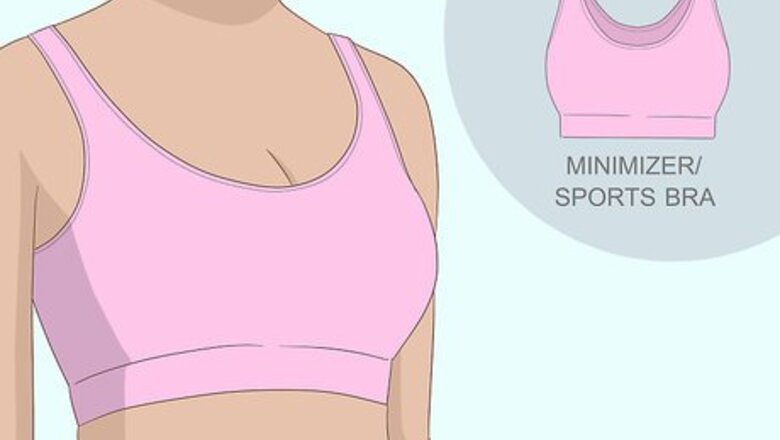
views
Using Physical Appearance

Use a minimizing or sports bra. Minimizing bras are specialty bras that specifically don’t add bulk. They may help if you just want to fit into particular clothes. Sports bras, however, not only provide support, but also flatten your chest. These are specially made for stopping breasts from moving during exercise, which can cause pain. Tip: If large, painful movements are a concern (for both physical and superficial reasons), sports bras may be the best solution for you.
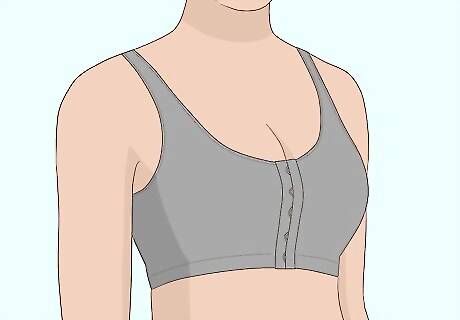
Try a shaper or chest binder. You probably have heard of Spanx or other shapers. These are items you wear under your clothes that suck everything in. You can buy ones that cover all sorts of different areas of your body but for you, one which covers the chest will be the most helpful. You might find these sold online under the word “shaper” or “chest binder,” but they will usually be roughly the same thing.
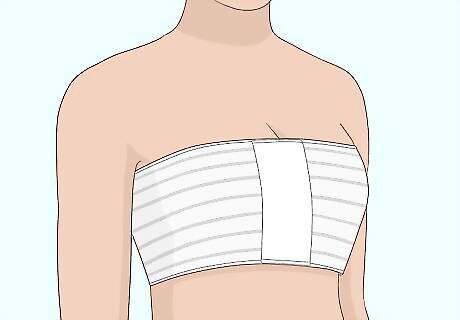
Try chest binding. If you're desperate and none of the other options have worked for you, you can use chest binding as a temporary solution. Choose a lightweight, air-permeable binding method like strategically layering clothing or using kinesiology tape to flatten your chest or make your breasts look smaller. Try not to sleep in your binder and identify one day each week to go binder-free and give your breasts a break.
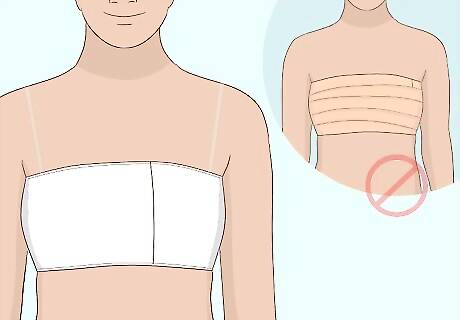
Be careful deciding what kind of binder to use. You can buy good, safe binders from many different sources online. Make sure any binder you wear is safe and will not cause any physical problems. Only bind with a specialized binder or kinesiology tape. Avoid using Ace bandages, duct tape, or plastic wrap. These materials aren’t breathable and can cause breathing problems, bruises, rib fractures, or damage your breasts when worn for extended periods. Binding materials like duct tape and plastic wrap are considered unsafe because they can result in moisture and skin breakage that can cause infection.
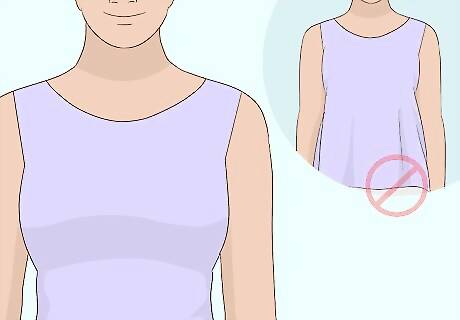
Wear a bra and clothes that fit. Wearing baggy clothes will only make you look larger all over and increase the problem. Wear clothes that aren’t tight, but fitted, and cover the breasts entirely to look good without attracting excessive attention. You'll want to do the same with your bra. Just wearing a bra that fits can make a huge difference in how your breasts feel.
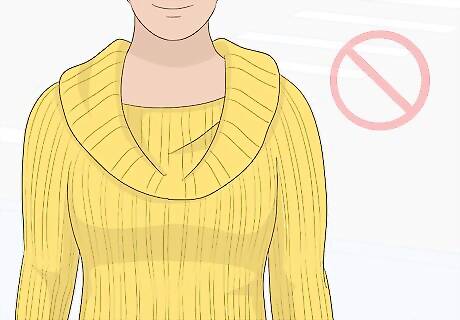
Avoid clothes that add bulk in the chest. Avoid cowl-neck sweaters and shirts, turtle neck shirts and sweaters, tops with puckers or gathers around the chest, ruffle-front shirts, and any other items which add volume to your chest. These will only make your chest look bigger. Instead, wear tops which are very minimal around the breasts. Certified stylist and vision consultant Sarah McDonald recommends not wearing shirts with “horizontal lines across your breasts” because they can make your chest look bigger. Instead, she recommends to wear “blazers and cardigans” because they can help cover up your breasts. McDonald also says to not wear “low cut” shirts. Instead, try to wear “a crew neck,” “a higher v neck,” or an off-the-shoulder shirt that “puts more emphasis on your shoulders.”
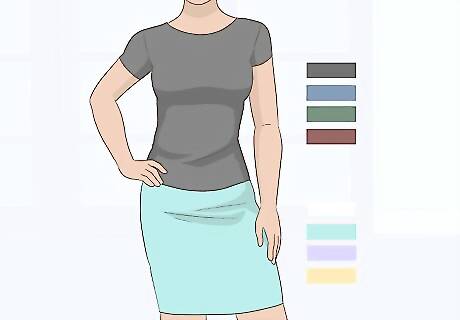
Wear dark tops and brightly colored pants or skirts. Certified stylist and vision consultant Sarah McDonald says that “darker colors always minimize and make things look smaller,” so if you’re trying to draw less attention to your chest, make sure to “always wear darker clothes.” This naturally attracts the line of vision downward, leading eyes away from your breasts. For example, wear a black fitted tee shirt and a teal jersey skirt. Or wear a navy blue blouse and bright white pants.
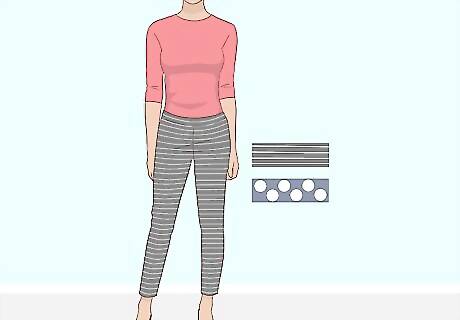
Accentuate your hips. If you want to naturally make your body look more balanced and draw attention away from your breasts, draw attention to your hips instead. Use pants with horizontal lines and full circle shirts to create the illusion of more volume in your hips, while also wearing tops that are plain and do not add bulk. This can define your waist and make your breasts look smaller.
Using Natural Methods

Stop doing anything that makes your breasts larger. You should always start by stopping certain things that make your breasts bigger naturally. The most common culprit will be birth control pills, which can cause your breasts to swell. Talk to your doctor about non-hormone based alternatives. A good alternative option to birth control pills for women might be a copper IUD. Pregnancy and breastfeeding can also cause your breasts to grow a cup size or two. However, try not to act against these states because they’re natural and temporary.
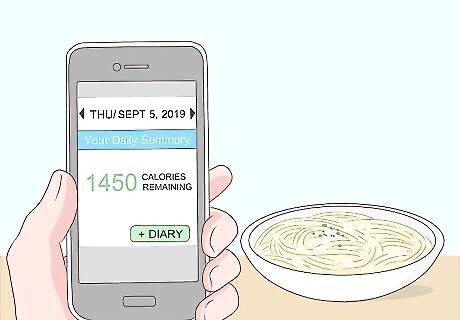
Create a calorie deficit. Calories are the fuel that our body uses and in order to burn fat (which is the main contributor to your bust line), you'll need to give it less fuel than it needs. This doesn't mean starving yourself, it just means balancing your activity level with the amount of fuel it needs. Lowering the amount of food you eat by a small amount while increasing your activity by a small amount can be enough to help you lose weight. Use an online calorie calculator to find out how to adjust your diet. This calorie deficit should only be temporary. Once you've reached a healthy target weight, balance your calorie intake with your activity level. Maintaining a healthy diet is more important than losing fat around your bust. If you are already at a healthy overall weight, losing additional weight to make your breasts smaller can be unhealthy. Maintaining a calorie deficit is only one factor involved in losing weight and excess fat. Eating healthy foods, exercising regularly, and avoiding processed foods can also help.
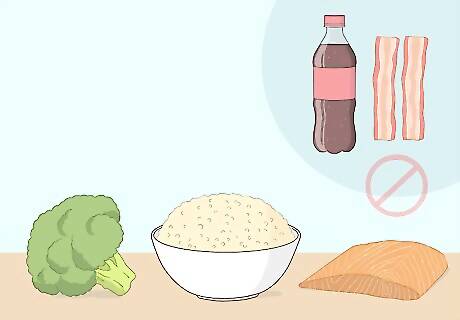
Eat a healthier diet. You'll want to eat a healthier diet that puts your calorie intake to work for you! By avoiding unhealthy items and increasing the nutritional value of the food that you do eat, you can make yourself feel more full with less food and easily decrease the number of calories you consume in a day. Eat healthy foods like kale, bananas, spinach, broccoli, quinoa, whole grain oatmeal, potatoes, lentils, edamame, white beans, fish, eggs, cottage cheese, and many other foods. Try to eat at least 5 portions of fruit and vegetables every day. Cut unhealthy items from your diet like trans and saturated fats, excessive salt, and sugar. All of these can contribute to weight gain and fat build-up. You can find these things in items like soda, syrup-laden coffee drinks, bacon, pork rinds, chips, butter, ice cream, and other similar foods.
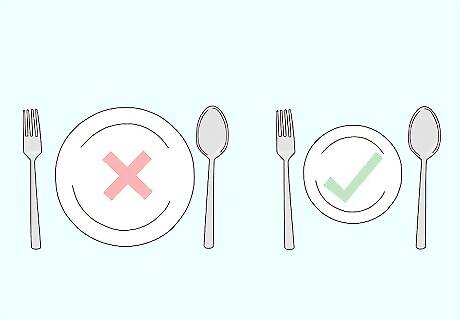
Eat better portions. Most people eat way too much food at one time. If it seems like it's the size of a restaurant meal, then it's too much food. A good practice is to eat your meals on a side plate instead of a dinner plate, and go back for seconds only if you are still hungry 15 minutes after you finish eating your first portion. Take a half serving for your "seconds". Eating very small meals more often is also a good way to practice portion control. This will also keep you feeling full all day.
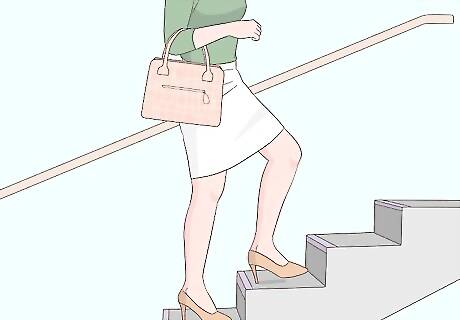
Get active in your everyday life. There are lots of ways that you can get active in your everyday life. To lose weight, try to get least 150 minutes of moderate aerobic activity (like walking briskly or biking) or 75 minutes of vigorous aerobic activity (like running, swimming laps, or roller blading) a week while maintaining a healthy calorie-deficeit diet. One of the easiest ways to get more exercise in your everyday life and start burning calories is to walk more. Take the stairs instead of the elevator and park further away from wherever you need to go in order to make sure you're walking a greater distance. Beyond that, try things like standing or treadmill desks or using an exercise ball instead of a chair. All of these use your normal activities and turn them into exercises!
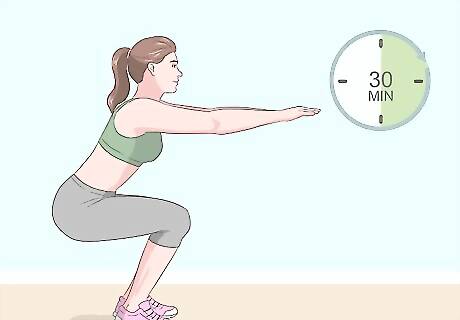
Exercise efficiently. It's easy to get bogged down with the clichéd push-ups and pull-ups, but there are more efficient exercises that can fit into your day much easier. Good examples include squats, planks, and burpees, all of which you can learn how to do in the wikiHow on exercising. Try to choose one or more of these exercises and do them for at least 15 minutes at a time at least 2 times a week. Squats and planks are both core exercises. If you only do these, it's a good idea to walk more. Try to spend another 30 minutes total every day walking, and the more stairs and hills involved, the better.
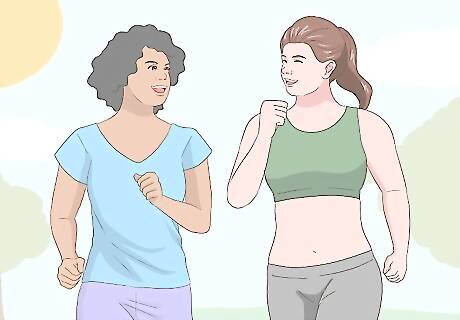
Stay motivated. Exercise needs to be consistent and prolonged in order to have any real effect. You'll have to make a real lifestyle change if you want the weight to stay off. This is why it's important to stay motivated. Having an exercise partner, a trainer, or someone else you're responsible to can really help. Listening to music while you exercise can also make it much more fun. You can also listen to audiobooks or podcasts too!
Using Surgery

Talk to your doctor. Talk to your doctor before putting too much consideration into breast reduction surgery and talking to a plastic surgeon (who may have too much of a vested interest in getting your money). Breast reduction surgery has the same risks as other major surgeries, and you could risk infection, a bad reaction to anesthesia, scarring, and difficulty breastfeeding. This kind of procedure is best done when breasts are fully developed. If you’re young, give yourself time. You may find you feel very different about your body in a few years.
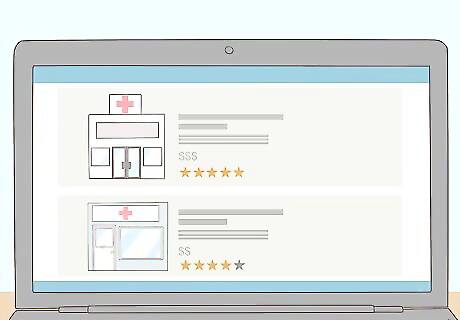
Do your research. Research the best plastic surgery facilities in your area. If there aren’t any highly acclaimed or reviewed locations nearby, it may be worth your while to go out of your way to find one. Again, plastic surgery is risky, and you want the best treatment you can find. Board certified plastic surgeon Dr. Daniel Barrett says your doctor should be licensed to practice medicine and certified with the American Board of Plastic Surgery.
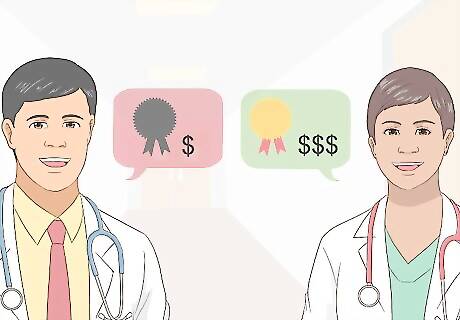
Get a consultation. Get a consultation with a couple of different plastic surgeons. They will be able to advise you on the different methods of breast reduction and the results that can be achieved. They will also be able to advise on costs and other considerations. You should not choose any surgeon that seems untrustworthy or offers extremely cheap procedures. When visiting a surgeon, ask how frequently they perform breast reduction surgery and how many surgeries they’ve performed. Ask for “before and after” photos so you can see each surgeon’s aesthetic style, which can play a role in how your breasts will look after the surgery.
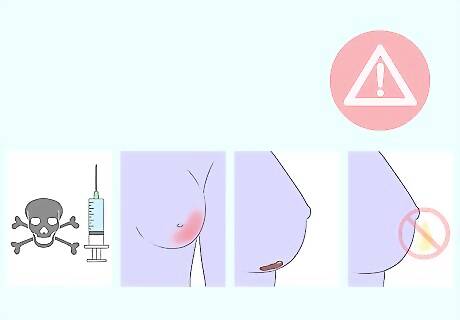
Recognize the risks. There are a number of risks associated with breast reduction surgery, many of which are also carried with any other surgery. You may have a serious allergic reaction to the anaesthesia, wake up during your operation, or in very rare cases, die. You may also develop an infection or blood clots. Other risks include: You run the risk of scarring, which may even go so far as to form keloids. You may end up with uneven or unusually shaped nipples. You may lose the ability to breastfeed if you ever plan to have children. Ask your doctor about your risk for complications and what can be done to lower your potential for problems post-surgery.

Accept the permanence. Breast surgery is permanent and in most cases cannot be undone. This is obviously a problem if the procedure is done poorly, but it is also important to remember that what's in fashion now or what you like now might not always be so desirable. You may come to love your body just the way it is and if you have surgery, you won't be able to get it back. However, if you get the surgery, your breasts may change over time due to aging, losing or gaining weight, hormonal factors, and gravity.

Make sure you can afford it. Breast reduction surgery is often covered by health insurance plans, but if your plan doesn’t, the procedure might be expensive. Weigh your priorities to make sure that this is right for you, since spending the money on an investment like school might be more beneficial for you in the long run. The average cost of breast reduction surgery is $6,771.
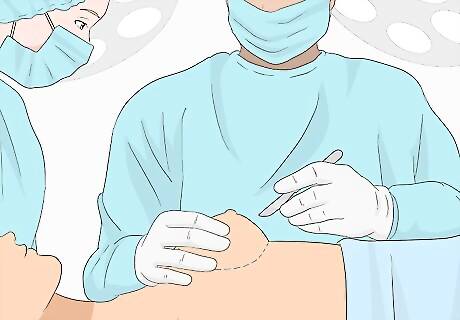
Get the surgery. Once you've weighed all your options and have made a decision, you'll need to go and get the surgery. It is usually done at a hospital or surgical center, requires general anesthesia, and is completed in a few hours. Generally, you will be sent home the same day, so you'll need to have someone available to pick you up.
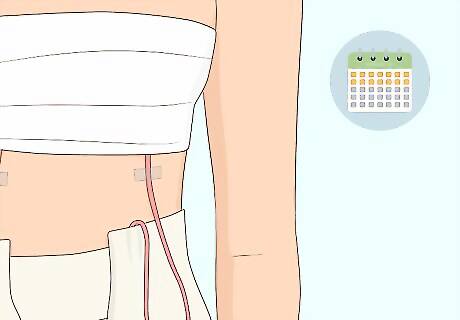
Go through the aftercare. You'll have to be extremely vigilant as you go through the aftercare process. You'll need to stay home from work for 1 to 2 weeks and avoid doing strenuous activities for at least a month.. You may experience swelling or bruising over the first few weeks, and your surgeon might recommend wearing an elastic pressure garment for extra support and protection. Your surgeon will provide you with the date of your follow-up appointment to remove your bandages and stitches.
















Comments
0 comment